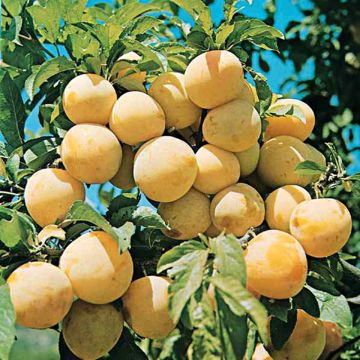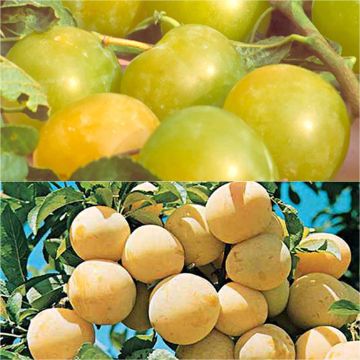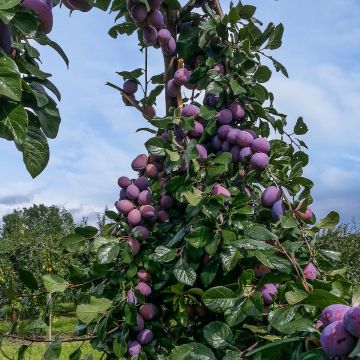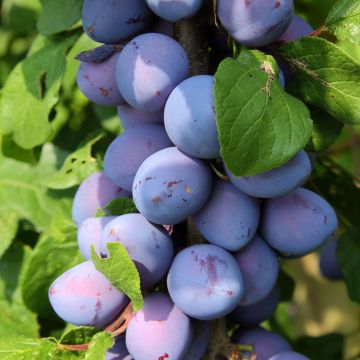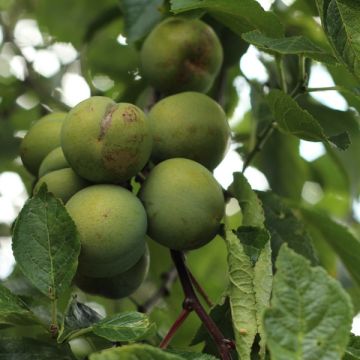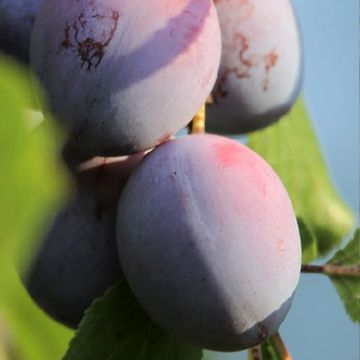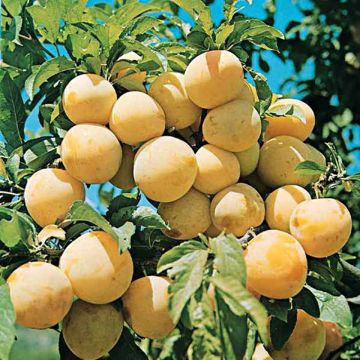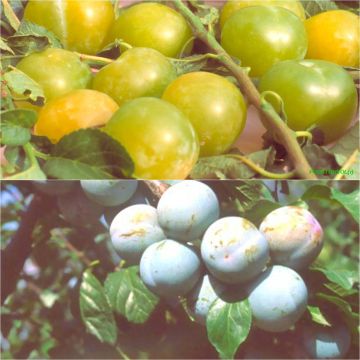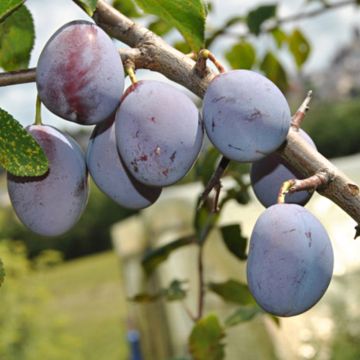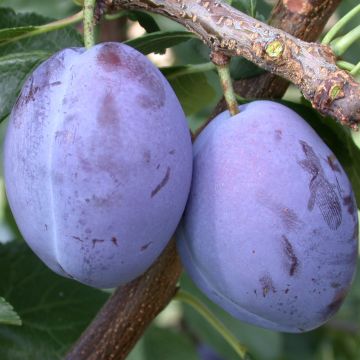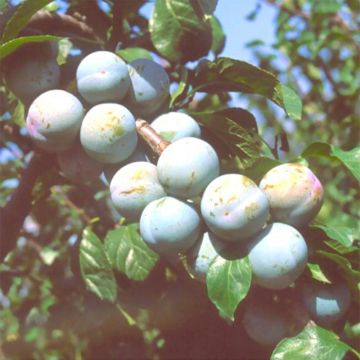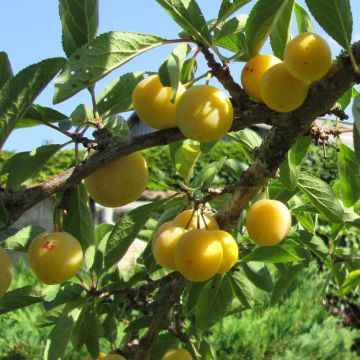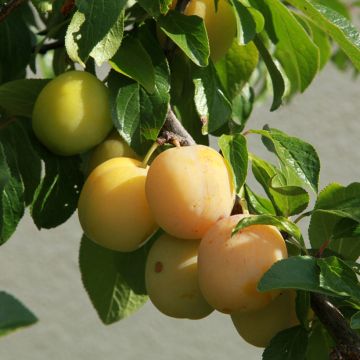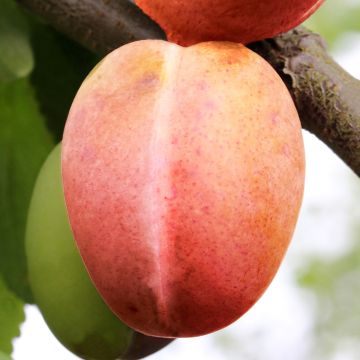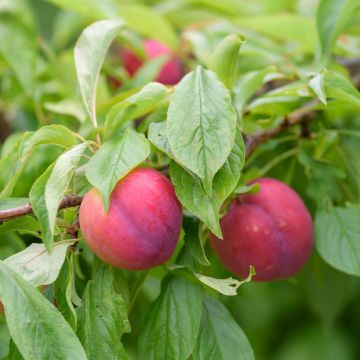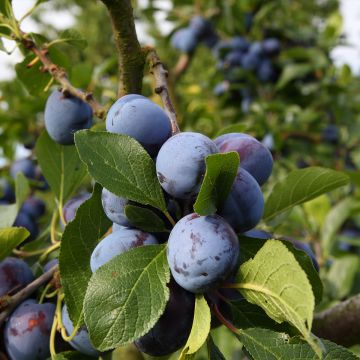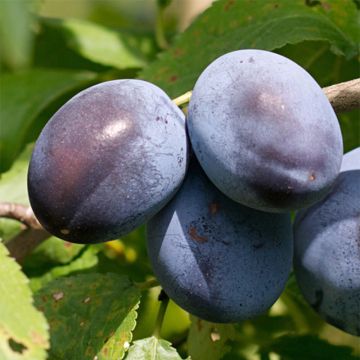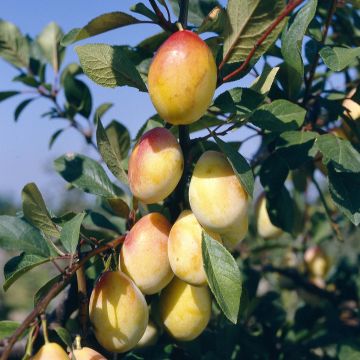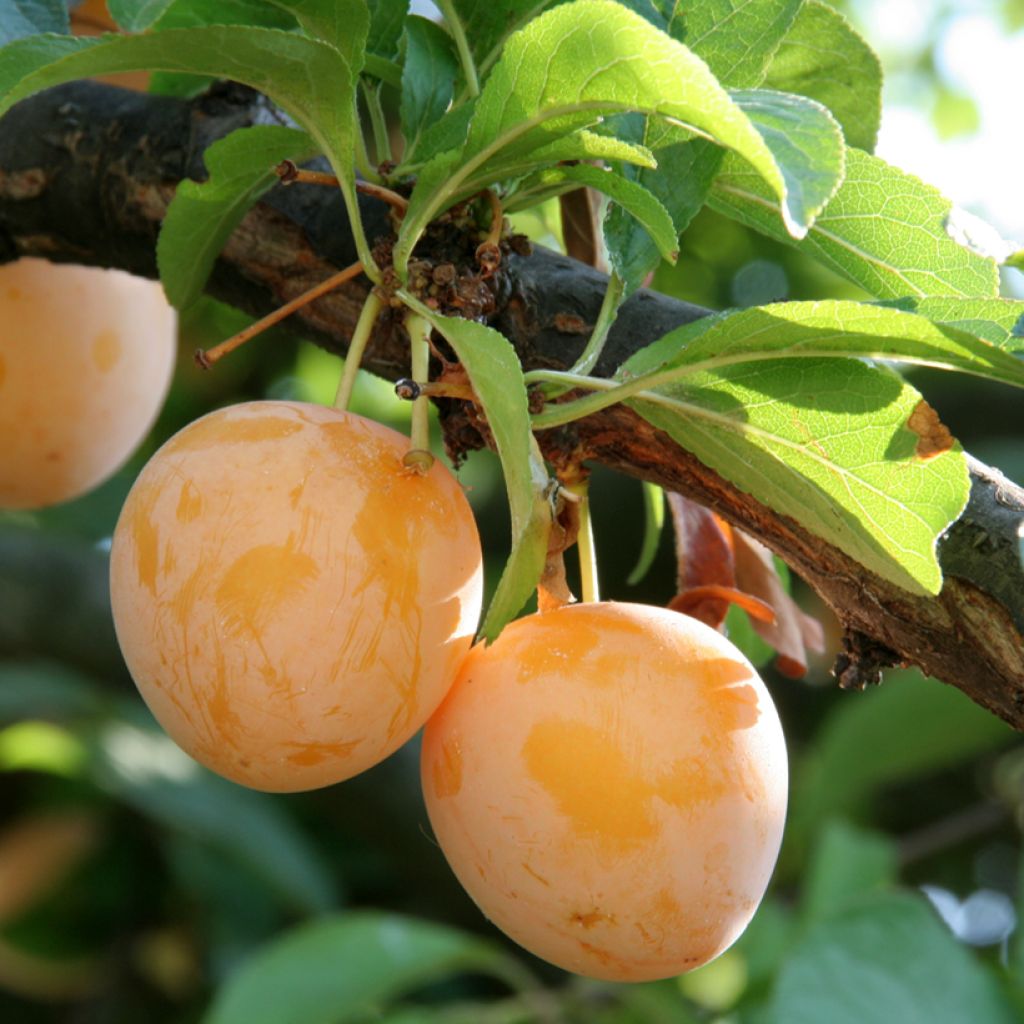

Prunier Des Béjonnières
Prunus domestica Des Béjonnières - Common plum
Prunus domestica Des Béjonnières
European plum, Common plum, Garden plum
Lovely bush, well pruned, beautiful presentation, well wrapped. Perfect delivery as always. Thanks to the DPD company and especially to its delivery driver. Thanks to everyone and a little early Happy New Year to All.
François, 09/12/2024
Why not try an alternative variety in stock?
View all →This plant carries a 6 months recovery warranty
More information
We guarantee the quality of our plants for a full growing cycle, and will replace at our expense any plant that fails to recover under normal climatic and planting conditions.
Oversize package: home delivery by special carrier from €6.90 per order..
Express home delivery from €8.90.
From €5.90 for pickup delivery and €6.90 for home delivery
Express home delivery from €8.90.
Delivery to Corse prohibited: UE law prohibits the import of this plant from mainland France to Corse as part of the fight against Xylella fastidiosa. Please accept our sincere apologies.
More information

Description
Prunus domestica Des Béjonnières is a vigorous, self-fertile variety with abundant and regular harvests. It produces a medium-sized, round fruit, with fine, yellow-gold skin with red spots and dots. Its translucent yellow flesh is firm, juicy, melting and pleasantly sweet, with an apricot flavour. Harvesting begins in early August, and the fruits can be eaten as they ripen. It is a pleasant fruit to enjoy fresh, cooked in sweet-savoury recipes, or preserved. This self-fertile variety has proven its good resistance to diseases, especially the plum moth, known as the codling moth. It adapts well to ordinary, filtering, fresh, deep, and rich soil, not too chalky and without stagnant moisture.
Prunus domestica (Common Plum) is a fruit tree belonging to the Rosaceae family, just like the apricot tree, the almond tree, and the peach tree. It is native to Syria, where it sometimes grows up to 1000 metres (3281 feet) in altitude. The Des Béjonnières variety was selected in 1827 by Monsieur André Leroy (1801-1875), a universalist and innovative nurseryman from Anjou.
Prunus domestica Des Béjonnières forms a fruit tree with a fairly rounded framework that can reach a final height of about 5 metres (16 feet), producing numerous branches grouped in spreading crowns. Its habit is well suited to free forms on high, half, or low stems. Its deciduous foliage consists of obovate leaves, 6 to 8 cm (2 to 3in) long, with crenate and dentate edges, slightly hairy underneath, and dark green. Towards the end of March or beginning of April, white, 1.5 to 2.5 cm (1in) in diameter flowers, appear solitarily before the leaves, on the previous year's branches. The flowering is sensitive to spring frosts, but it is so abundant that frost rarely affects the harvest. It has a remarkably decorative blossom in spring, particularly attractive to bees and nectar-loving insects. It is hardy down to -20°C. This variety is self-fertile, so it does not need a companion to bear fruit, but the presence of another plum tree variety nearby will increase production.
Prunus domestica Des Béjonnières is a fertile variety that bears fruit quickly. The fruits are harvested throughout August, as they ripen. Since plums are quite delicate, they should be carefully harvested with a picking pole or manually with a ladder. On average, a plum tree yields between 25 and 50 kilograms of fruit per year. The fruits are consumed immediately after harvesting. They are medium-sized, ovoid, 3 to 4 cm (1 to 2in) diameter plums, with delicious and juicy flesh. The plums can be eaten fresh from the tree, raw or mixed in a fruit salad, or used in desserts. They are also exquisite in clafoutis, cakes, crumbles, or pies, and as an accompaniment to savoury dishes with white meats (turkey, chicken, veal, etc.) or tagines. They are also perfect for making jams, compotes, or preserved in syrup.
Plums are a light and balancing fruit. They are low in calories and rich in potassium, calcium, and magnesium, with a significant iron content. Their content of vitamins C, B, E, and K, phenolic antioxidants, and fibre make plums a healthy choice. They are invigorating, energizing, and rehydrating. The fruits only keep for a few days at room temperature. However, they can be frozen once washed, dried, and pitted or preserved in jams or syrup.
Prunus domestica Des Béjonnières is a mirabelle plum, an extremely versatile variety in its culinary uses, and its advantages as a fruit tree make it a preferred choice. Under good conditions, it is easy to grow, generous in fruit, and resistant to diseases. Extremely popular, thanks to its fruits, the plum tree is loved by young and old alike. With a wide range of varieties, it is easy to find one that suits.
Report an error about the product description
Prunus domestica Des Béjonnières - Common plum in pictures
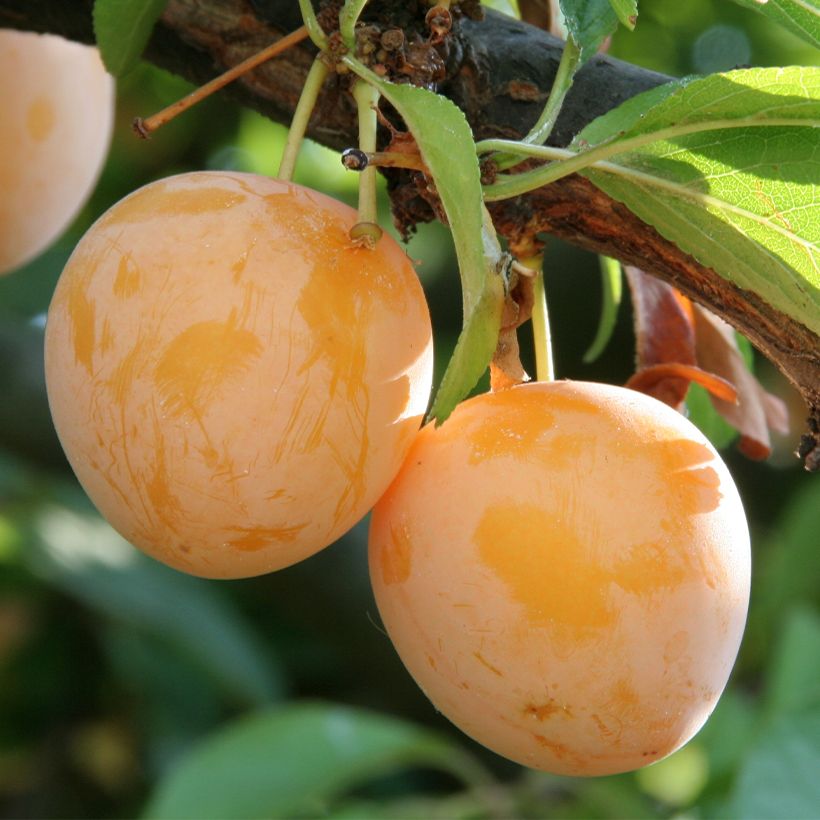

Plant habit
Fruit
Flowering
Foliage
Botanical data
Prunus
domestica
Des Béjonnières
Rosaceae
European plum, Common plum, Garden plum
Cultivar or hybrid
Other Plum Trees
Planting and care
This perfectly hardy Béjonnières plum withstands temperatures well below -15°C and can be cultivated up to 1000 m (3281ft) in altitude. Under good conditions, it is one of the easiest fruit trees to grow, generous and resistant. Plum trees bloom early in spring and are therefore exposed to frost, although frost rarely affects plum harvests. Avoid areas that are too exposed to north and east winds in the coldest regions. To produce beautiful fruits, the plum tree needs heat and well-sunlit positions, sheltered from strong winds (the branches are very brittle). It is a vigorous tree that is suitable for all soils, although it prefers rich, moist, deep, well-drained soils that are slightly acidic, without stagnant moisture or excessive limestone. It only really dislikes waterlogged soils. The plum tree is only grown in free forms in open ground. It brings a touch of freshness to a natural garden and an orchard in spring with its white blossom.
Plant the plum tree from November to March, during the rest period, avoiding frosts. Container-grown trees can be planted all year round, provided the soil is neither frozen nor waterlogged. In open ground, plant the plum tree in groups of 3 or 5, spacing the plants 6 to 7 m (20 to 23ft) apart.
Prepare the soil well. Dig a large planting hole at least 3 times the volume of the root ball (80×80 cm (32in)). Ensure good drainage by adding a little gravel. Install the tree in the hole and plant a stake without tying it too tightly. Fill in and firm the soil gradually with garden soil enriched with well-rotted compost and 2 or 3 handfuls of bonemeal, without burying the graft collar (leave the graft point 10 cm (4in) above the ground). Form a basin around the base and water abundantly and regularly to help your plum tree establish.
Water regularly for the first three years, as the soil must remain moist throughout the summer. It does not like excessively dry soils. If there is a lack of water, its fruits may fall prematurely. After 2 or 3 years, it will withstand a short period of drought better. Mulch the base of your plum tree during the first few years with dry vegetation (bark, dead leaves, straw, etc.) to retain moisture in the summer.
If necessary, thin out the fruits. Ripe plums attract wasps: collect fallen fruits from the ground. If necessary, remove any shoots that grow at the base of the tree, but be careful when hoeing, as its roots are shallow. In autumn or spring, apply manure or fertiliser for fruit trees.
Planting period
Intended location
Care
-
, onOrder confirmed
Reply from on Promesse de fleurs
Haven't found what you were looking for?
Hardiness is the lowest winter temperature a plant can endure without suffering serious damage or even dying. However, hardiness is affected by location (a sheltered area, such as a patio), protection (winter cover) and soil type (hardiness is improved by well-drained soil).

Photo Sharing Terms & Conditions
In order to encourage gardeners to interact and share their experiences, Promesse de fleurs offers various media enabling content to be uploaded onto its Site - in particular via the ‘Photo sharing’ module.
The User agrees to refrain from:
- Posting any content that is illegal, prejudicial, insulting, racist, inciteful to hatred, revisionist, contrary to public decency, that infringes on privacy or on the privacy rights of third parties, in particular the publicity rights of persons and goods, intellectual property rights, or the right to privacy.
- Submitting content on behalf of a third party;
- Impersonate the identity of a third party and/or publish any personal information about a third party;
In general, the User undertakes to refrain from any unethical behaviour.
All Content (in particular text, comments, files, images, photos, videos, creative works, etc.), which may be subject to property or intellectual property rights, image or other private rights, shall remain the property of the User, subject to the limited rights granted by the terms of the licence granted by Promesse de fleurs as stated below. Users are at liberty to publish or not to publish such Content on the Site, notably via the ‘Photo Sharing’ facility, and accept that this Content shall be made public and freely accessible, notably on the Internet.
Users further acknowledge, undertake to have ,and guarantee that they hold all necessary rights and permissions to publish such material on the Site, in particular with regard to the legislation in force pertaining to any privacy, property, intellectual property, image, or contractual rights, or rights of any other nature. By publishing such Content on the Site, Users acknowledge accepting full liability as publishers of the Content within the meaning of the law, and grant Promesse de fleurs, free of charge, an inclusive, worldwide licence for the said Content for the entire duration of its publication, including all reproduction, representation, up/downloading, displaying, performing, transmission, and storage rights.
Users also grant permission for their name to be linked to the Content and accept that this link may not always be made available.
By engaging in posting material, Users consent to their Content becoming automatically accessible on the Internet, in particular on other sites and/or blogs and/or web pages of the Promesse de fleurs site, including in particular social pages and the Promesse de fleurs catalogue.
Users may secure the removal of entrusted content free of charge by issuing a simple request via our contact form.
The flowering period indicated on our website applies to countries and regions located in USDA zone 8 (France, the United Kingdom, Ireland, the Netherlands, etc.)
It will vary according to where you live:
- In zones 9 to 10 (Italy, Spain, Greece, etc.), flowering will occur about 2 to 4 weeks earlier.
- In zones 6 to 7 (Germany, Poland, Slovenia, and lower mountainous regions), flowering will be delayed by 2 to 3 weeks.
- In zone 5 (Central Europe, Scandinavia), blooming will be delayed by 3 to 5 weeks.
In temperate climates, pruning of spring-flowering shrubs (forsythia, spireas, etc.) should be done just after flowering.
Pruning of summer-flowering shrubs (Indian Lilac, Perovskia, etc.) can be done in winter or spring.
In cold regions as well as with frost-sensitive plants, avoid pruning too early when severe frosts may still occur.
The planting period indicated on our website applies to countries and regions located in USDA zone 8 (France, United Kingdom, Ireland, Netherlands).
It will vary according to where you live:
- In Mediterranean zones (Marseille, Madrid, Milan, etc.), autumn and winter are the best planting periods.
- In continental zones (Strasbourg, Munich, Vienna, etc.), delay planting by 2 to 3 weeks in spring and bring it forward by 2 to 4 weeks in autumn.
- In mountainous regions (the Alps, Pyrenees, Carpathians, etc.), it is best to plant in late spring (May-June) or late summer (August-September).
The harvesting period indicated on our website applies to countries and regions in USDA zone 8 (France, England, Ireland, the Netherlands).
In colder areas (Scandinavia, Poland, Austria...) fruit and vegetable harvests are likely to be delayed by 3-4 weeks.
In warmer areas (Italy, Spain, Greece, etc.), harvesting will probably take place earlier, depending on weather conditions.
The sowing periods indicated on our website apply to countries and regions within USDA Zone 8 (France, UK, Ireland, Netherlands).
In colder areas (Scandinavia, Poland, Austria...), delay any outdoor sowing by 3-4 weeks, or sow under glass.
In warmer climes (Italy, Spain, Greece, etc.), bring outdoor sowing forward by a few weeks.


































